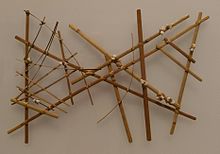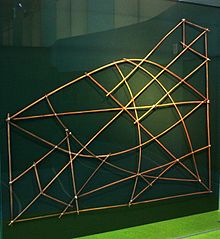Micronesian navigation

Micronesian navigation techniques are those navigation skills used for thousands of years by the navigators who voyaged between the thousands of small islands in the western
Early voyaging
Based on the current scientific consensus, the
The
People from the

In April 1970, Repunglug and Repunglap, half-brothers, navigated from Satawal to Saipan in a traditional Carolinian outrigger canoe, which was approximately 26 feet (7.92 m) long, and equipped with a canvas sail.[21] This voyage was understood on Satawal to be the first time in the 20th century that a traditional canoe had made the voyage to Saipan.[21] While they used a small boat compass, they relied on their knowledge of traditional stellar navigation and wave patterns to sail approximately 52 miles (84 km) to West Fayu, where they waited for favourable winds before continuing on the 422 miles (679 km) voyage to Saipan.[21] They later made the return journey to Satawal.[21]
In the early 1970's there were at least 17 men who could serve as a master navigator (palu) for voyages to the Marianas. They include Sautan on
The Carolinian navigation system, used by Mau Piailug, relies on navigational clues using the Sun and stars, winds and clouds, seas and swells, observing the flight path of birds, and the patterns of bioluminescence that indicated the direction in which islands were located,[22][23] which skills were acquired through rote learning passed down through teachings in the oral tradition.[24]
Once they had arrived fairly close to a destination island, the navigator would have been able to pinpoint its location by sightings of land-based birds, the cloud formations that form over islands, as well as the reflections of shallow water made on the undersides of clouds. Subtle differences in the colour of the sky also could be recognised as resulting from the presence of lagoons or shallow waters, as deep water was a poor reflector of light while the lighter colour of the water of lagoons and shallow waters could be identified in the reflection in the sky.[2]
These wayfinding navigation technique relies heavily on constant observation and memorization. Navigators have to memorize where they have sailed from in order to know where they are. The sun was the main guide for navigators because they could follow its exact points as it rose and set. Once the sun had set they would use the rising and setting points of the stars. When there were no stars because of a cloudy night or during daylight, a navigator would use the winds and swells as guides.[24][23]
The positions of the stars helped guide voyages. Stars, as opposed to planets, hold fixed celestial positions year-round, changing only their rising time with the seasons. Each star has a specific declination, and can give a bearing for navigation as it rises or sets.
For navigators near the equator, (as navigators sailing between the islands of Micronesia), celestial navigation is simplified, given that the whole celestial sphere is exposed. Any star that passes through the zenith (overhead) moves along the celestial equator, the basis of the equatorial coordinate system. Voyagers would set a heading by a star near the horizon, switching to a new one once the first rose too high. A specific sequence of stars would be memorized for each route.[2][3][22]
Navigating by the stars requires knowledge of when particular stars, as they rotated through the night sky, would pass over the island to which the voyagers were sailing. The technique of "sailing down the latitude" was used.[2][3] That is, knowledge that the movement of stars over different islands followed a similar pattern, (by recognising that different islands have a similar relationship to the night sky) provided the navigators with a sense of latitude, so that they could sail with the prevailing wind, before turning east or west to reach the island that was their destination.[1][2]


Navigators could also observe the direction of the wave and swell formations to navigate caused by islands. Many of the habitable areas of the Pacific Ocean are groups of islands (or atolls) in chains hundreds of kilometres long. Island chains have predictable effects on waves and currents. Navigators who lived within a group of islands would learn the effect various islands had on the swell shape, direction, and motion, and would have been able to correct their path accordingly. Even when they arrived in the vicinity of an unfamiliar chain of islands, they may have been able to detect signs similar to those of their home.[2]
The energy transferred from the wind to the sea produces wind waves. The waves that are created when the energy travels down away from the source area (like ripples) are known as swell. When the winds are strong at the source area, the swell is larger. The longer the wind blows, the longer the swell lasts. Because the swells of the ocean can remain consistent for days, navigators relied on them to carry their canoe in a straight line from one house (or point) on the star compass to the opposite house of the same name. Navigators were not always able to see stars; because of this, they relied on the swells of the ocean. Swell patterns are a much more reliable method of navigation than waves, which are determined by the local winds.[2][3] Swells move in a straight direction which makes it easier for the navigator to determine whether the canoe is heading in the correct direction.[26]
The people of the
Vessels
Sources
- Lewis, David(1963), "A Return Voyage Between Puluwat and Saipan Using Micronesian Navigational Techniques", in Finney, Ben R (ed.), Pacific Navigation and Voyaging, The Polynesian Society.
- Lewis, David (1994), University of Hawaii Press.
- O’Connor, M.R. (2019). Wayfinding: The Science and Mystery of How Humans Navigate the World. St. Martin's Press. ISBN 978-1250096968.
References
- ^ a b Holmes, Lowell Don (1 June 1955). "Island Migrations (1): The Polynesian Navigators Followed a Unique Plan". XXV(11) Pacific Islands Monthly. Archived from the original on 1 October 2021. Retrieved 1 October 2021.
- ^ a b c d e f g h Holmes, Lowell Don (1 August 1955). "Island Migrations (2): Birds and Sea Currents Aided Canoe Navigators". XXVI(1) Pacific Islands Monthly. Archived from the original on 1 October 2021. Retrieved 1 October 2021.
- ^ a b c d e Holmes, Lowell Don (1 September 1955). "Island Migrations (3): Navigation was an Exact Science for Leaders". XXVI(2) Pacific Islands Monthly. Archived from the original on 1 October 2021. Retrieved 1 October 2021.
- ^ a b Lewis, David (1974). "Wind, Wave, Star, and Bird". National Geographic. 146 (6): 747–754, 771–778.
- ISBN 9780890961070.
- ISBN 9780071594561.
- JSTOR 25168892.
- ^ Bellwood, Peter (1988). "A Hypothesis for Austronesian Origins" (PDF). Asian Perspectives. 26 (1): 107–117. Archived (PDF) from the original on 1 May 2019. Retrieved 1 May 2019.
- JSTOR 24936983.
- ISBN 9780198576952.
- ISBN 9781920942854. Archivedfrom the original on 2 April 2020. Retrieved 23 March 2019.
- ISBN 9789971696429. Archived(PDF) from the original on 30 December 2019. Retrieved 23 March 2019.
- .
- ^ Zotomayor, Alexie Villegas (March 12, 2013). "Archaeologists say migration to Marianas longest ocean-crossing in human history". Marianas Variety News and Views: 2. Archived from the original on October 21, 2022. Retrieved October 25, 2020.
- ^ Zotomayor, Alexie (March 11, 2013). "Archaeologist says migration to Marianas longest ocean-crossing in human history". Marianas Variety. Archived from the original on March 16, 2017. Retrieved December 29, 2014.
- ^ Peterson, John A. (2012). "Latte villages in Guam and the Marianas: Monumentality or monumenterity?" (PDF). Micronesica. 42 (1/2): 183–208. Archived (PDF) from the original on 2019-04-12. Retrieved 2021-10-04.
- ISBN 0-393-03226-4.
- ISBN 0-520-08002-5.
- ISBN 0-674-22425-6.
- ^ Lewis, David (1974). "Wind, Wave, Star, and Bird". National Geographic. 146 (6): 771–778.
- ^ Auckland University. Archivedfrom the original on 2021-12-28. Retrieved 2021-10-07.
- ^ ISBN 9780824802295.
- ^ a b Lewis, David (1974). "Wind, Wave, Star, and Bird". National Geographic. 146 (6): 747–754, 771–778.
- ^ a b Thompson, Nainoa. "On Wayfinding". Polynesian Voyaging Society. Archived from the original on November 2, 2017. Retrieved April 11, 2018.
- ^ "Star Compasses". Polynesian Voyaging Society. Archived from the original on 24 October 2011.
- ISBN 9781473615205.
- ^ Finney, Ben (1998). "13: Nautical Cartography and Traditional Navigation in Oceania" (PDF). In Woodward, David; Lewis, G. Malcolm (eds.). The History of Cartography. Vol. 2.3: Cartography in the Traditional African, American, Arctic, Australian, and Pacific Societies. p. 476. Archived (PDF) from the original on 2021-10-04. Retrieved 2021-10-04.





